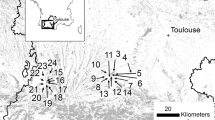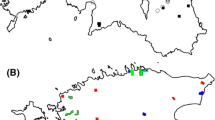Abstract
Coppice systems are amongst the earliest forms of woodland management known, and on some sites, their use has been documented for centuries. Distinctive assemblages of plants and animals are associated with such systems and are highly valued in nature conservation terms. The richness of such assemblages, and conversely, the species that do not thrive under coppice, are linked to the alternation of relatively short light and dark phases, and the juxtaposition of stands at different stages in the coppice cycle. Vascular plants in the ground flora, invertebrates of open glades and scrub, and small birds of the understorey may have become more abundant in coppice than they would have been under ‘natural’ forest conditions. By contrast, epiphytes dependent on mature trees and species of large-sized deadwood are less favoured by coppice management. Coppice systems developed to meet the local community needs. As social and economic conditions changed, so coppicing declined and the woods were transformed into high forest through neglect or deliberate management. High forests differ from coppice stands in their spatial and temporal dynamics, and consequently, in their wildlife, particularly with respect to their vertical structure pattern, extent of open space and young growth, spatial heterogeneity, tree and shrub composition, and browsing levels. Three issues for the conservation of biodiversity arise from these changes: (1) What priority and resources should be given to halting further decline, by maintaining coppice compared to allowing sites to develop with more ‘natural’ high forest structures and dynamics; will associated high-forest species recolonize? (2) If we restore coppice systems, will the species assemblages present in the past also recover, under current and future changes in environmental conditions; i.e is the transformation reversible under current environmental conditions? (3) Are there other ways in which ‘coppice-associated’ species might be maintained? We identify research gaps and proposals to address these issues.

Similar content being viewed by others
References
Amar A, Hewson CM, Thewlis RM, Smith KW, Fuller RJ, Lindsell JA, Conway G, Butler S, MacDonald MA (2006). Long-term changes in the populations of woodland birds. RSPB / BTO Research Report, Thetford and Sandy, UK
Ash JE, Barkham JP (1976) Changes and variability in the field layer of a coppiced woodland in Norfolk, England. J Ecol 64:697–712
Asher J, Warren M, Fox R, Harding P, Jeffcoate G, Jeffcoate S (2001) The millennium atlas of butterflies in Britain and Ireland. Oxford University Press, Oxford
Bailey S (2007) Increasing connectivity in fragmented landscapes: an investigation of evidence for biodiversity gain in woodlands. Forest Ecol Managem 238:7–23
Barkham JP (1992) The effects of coppicing and neglect on the performance of the perennial ground flora. In Buckley, GP (ed) Ecology and management of coppice woodlands. Chapman and Hall, London, pp 115–146
Bastrup-Birk A (2014) Developing a forest naturalness indicator for Europe. European Environment Agency, Luxembourg
Bright PW, Morris PA (1990) Habitat requirements of dormice Muscardinus avellanarius in relation to woodland management in Southwest England. Biol Conservation 54:307–326
Bright PW, Morris P, Mitchell-Jones T (2006) The dormouse conservation handbook. English Nature, Peterborough, UK
Brouwers N, Newton A (2010) The influence of barriers and orientation on the dispersal ability of wood cricket (Nemobius sylvestris) (Orthoptera: Gryllidae). J Insect Conservation 14:313–317
Buckley GP (ed) (1992) Ecology and management of coppiced woodland. Chapman and Hall, London.
Buckley GP, Mills J (2015a) Coppice silviculture: from the Mesolithic to 21st century. In Kirby KJ, Watkins C (eds.) Europe's changing woods and forests: from wildwood to managed landscapes. CABI, Wallingford, UK, pp 77–92
Buckley GP, Mills J (2015b). The flora and fauna of coppice woods: winners and losers of active management or neglect. In Kirby KJ, Watkins C (eds) Europe's changing woods and forests: from wildwood to managed landscapes. CABI, Wallingford, UK, pp 129–139
Buckley GP, Howell R, Anderson MA (1997) Vegetation succession following ride edge management in lowland plantations and woods. 2. The seed bank resource. Biol Conservation 82:305–316
Cooke AS, Farrell L (2001) Impact of muntjac deer (Muntiacus reevesi) at Monks Wood National Nature Reserve, Cambridgeshire, eastern England. Forestry 74:241–250
Dzwonko Z, Gawroński S (2002) Effect of litter removal on species richness and acidification of a mixed oak-pine woodland. Biol Conservation 106:389–398
Edlin HL (1949). Woodland crafts in Britain. Batsford, London
Edwards ME (1986) Disturbance histories of four Snowdonian woodlands and their relation to Atlantic bryophyte distributions. Biol Conservation 37:301–320
Foot D (2010) Woods and people: putting forestry on the map. The History Press, Stroud, UK
Ford ED, Newbould PJ (1977) The biomass and production of ground vegetation and Its relation to tree cover through a deciduous woodland cycle. J Ecol 65:201–212
Fuller RJ (1992) Effects of coppice management on woodland breeding birds. In Buckley GP (ed) Ecology and management of coppice woodlands, Chapman and Hall, London, pp 169–192
Fuller RJ, Gill R (2001) Ecological impacts of deer in British woodland. Forestry 74:193–299
Fuller RJ, Henderson ACB (1992) Distribution of breeding songbirds in Bradfield Woods, Suffolk, in relation to vegetation and coppice management. Bird Study 39:73–88
Fuller RJ, Warren MS (1993) Coppiced woodlands: their value for wildlife. Joint Nature Conservation Committee, Peterborough, UK
Grove AT, Rackham O (2001) The nature of Mediterranean Europe: an ecological history. Yale University Press, New Haven and London
Hambler C, Speight MR (1995) Biodiversity conservation in Britain: science replacing tradition. Brit Wildlife 6:137–137
Hartel T, Plieninger T, Varga A (2015) Wood-pastures in Europe. In Kirby KJ, Watkins C (eds). Europe's changing woods and forests: from wildwood to managed landscapes. CABI, Wallingford, UK, pp 61–76
HMSO (1952) Census of woodlands 1947–1949. HMSO, London
Hopkins JJ, Kirby KJ (2007) Ecological change in British broadleaved woodland since 1947. Ibis 149:29–40
Kirby KJ (2001) The impact of deer on the ground flora of British broadleaved woodland. Forestry 74:219–229
Kirby KJ (2009) Effect of the shift from coppice to high forest in English Woods on the woodland flora. In Saratsi E, Burgi M, Johann E, Kirby KJ, Moreno D, Watkins C (eds) Woodland cultures in time and space. Embryo Publications, Athens, pp 155–162
Kirby KJ (2015) Changes in the vegetation of clear-fells and closed canopy stands in an English oak wood over a 30-year period. New J Bot 5:2–12
Kirby KJ, Buckley GP (eds) (1994) Ecological responses to the 1987 Great Storm in the woods of south-east England. English Nature Science Reports 23 English Nature, Peterborough, UK
Kirby KJ, Smart SM, Black HIJ, Bunce RGH, Corney PM, Smithers RJ (2005) Long term ecological change in British woodland (1971-2001). Peterborough, English Nature (Research Report 653)
Kirby KJ, Watkins C (eds) (2015a) Europe's changing woods and forests: from wildwood to managed landscapes, Wallingford, UK, CABI
Kirby KJ, Watkins C (2015b). The forest landscape before farming. In Kirby KJ, Watkins C (eds) Europe's changing woods and forests: from wildwood to managed landscapes. CABI, Wallingford, UK, pp 32–45
Kirby KJ, Mitchell FJG, Hester AJ (1994) A role for large herbivores (deer and domestic stock) in nature conservation management in British semi-natural woods. Arboric J 18:381–399
Kirby KJ, Reid CM, Thomas RC, Goldsmith FB (1998) Preliminary estimates of fallen dead wood and standing dead trees in managed and unmanaged forests in Britain. J Appl Ecol 35:148–155
Kirby KJ, Bazely DR, Goldberg EA, Hall JE, Isted R, Perry SC, Thomas RC (2014) Changes in the tree and shrub layer of Wytham Woods (Southern England) 1974–2012: local and national trends compared. Forestry 87:663–673
Koop H (1987) Vegetative reproduction of trees in some European natural forests. Vegetatio 72:103–110
Kreuz A (1992) Charcoal from ten early Neolithic settlements in Central Europe and its interpretation in terms of woodland management and wildwood resources. Bull Soc Bot France, Actual Bot 139:383–394
Miklín J, Čížek L (2014) Erasing a European biodiversity hot-spot: Open woodlands, veteran trees and mature forests succumb to forestry intensification, succession, and logging in a UNESCO Biosphere Reserve. J Nat Conservation 22:35–41
Mitchell FJG, Kirby KJ (1990) The impact of large herbivores on the conservation of semi-natural woods in the British uplands. Forestry 63:333–353
Mitchell RJ, Bailey S, Beaton JK, Bellamy PE, Brooker RW, Broome A, Chetcuti J, Eaton S, Ellis CJ, Farren J, Gimona A, Goldberg E, Hall J, Harmer R, Hester AJ, Hewison RL, Hodgetts NG, Hooper RJH, Iason GR, Kerr G, Littlewood NA, Morgan V, Newey S, Potts JM, Pozsgai G, Ray D, Sim DA, Stockan JA, Taylor AFS, Woodward S (2014) The potential ecological impact of ash dieback in the UK. JNCC Report 483. Peterborough, UK
Monbiot G (2013) Feral: searching for enchantment on the frontiers of rewilding, Penguin, UK.
Out WA (2010) Firewood collection strategies at Dutch wetland sites in the process of Neolithisation. The Holocene 20:191–204
Parviainen J, Bücking W, Vandekerkhove K, Schuck A, Päivinen R (2000) Strict forest reserves in Europe: efforts to enhance biodiversity and research on forests left for free development in Europe (EU-COST-Action E4). Forestry 73:107–118
Peterken GF (1996) Natural woodland. Cambridge University Press, Cambridge
Peterken GF (2015) Woodland history in the British Isles – an interaction of environmental and cultural forces. In Kirby KJ, Watkins C (eds) Europe's changing woods and forests: from wildwood to managed landscapes. CABI, Wallingford, UK, pp 265–278
Peterken GF, Allison, H (1989) Woods, trees and hedges: a review of changes in the British countryside, Nature Conservancy Council, Peterborough, UK.
Peterken GF, Mountford EP (2005) Natural woodland reserves – 69 years of trying at Lady Park Wood Reserve. Brit Wildlife 17:7–16
Plieninger T, Hartel T, Martín-López B, Beaufoy G, Bergmeier E, Kirby KJ, Montero MJ, Moreno G, Oteros-Rozas E, Van Uytvanck J (2015) Wood-pastures of Europe: Geographic coverage, social-ecological values, conservation management, and policy implications. Biol Conservation 190:70–79
Pollard E, Woiwod IP, Greatorex-Davies JN, Yates TJ, Welch RC (1998) The spread of coarse grasses and changes in numbers of Lepidoptera in a woodland nature reserve. Biol Conservation 84:17–24
Quine CP, Watts K (2009) Successful de-fragmentation of woodland by planting in an agricultural landscape? An assessment based on landscape indicators. J Environm Managem 90:251–259
Rackham O (1990) Trees and woodland in the British landscape (revised edition). Dent, London
Rackham O (2003) Ancient woodland: its history, vegetation and uses in England (revised edition), Castlepoint Press, Dalbeattie, Scotland
Ranius T, Niklasson M, Berg N (2009) Development of tree hollows in pedunculate oak (Quercus robur). Forest Ecol Managem 257:303–310
Rodwell JS (1991) British plant communities: 1 woodlands and scrub. Cambridge University Press, Cambridge
Siitonen J, Ranius T (2015) The importance of veteran trees for saproxylic insects. In Kirby KJ, Watkins C (eds) Europe's changing woods and forests: from wildwood to managed landscapes. CABI, Wallingford, UK, pp 140–153
Spencer JW, Kirby KJ (1992) An inventory of ancient woodland for England and Wales. Biol Conservation 62:77–93
Van Calster H, Chevalier R, Wyngene B, Archaux F, Verheyen K, Hermy M (2008) Long- term seed bank dynamics in a temperate forest under conversion from coppice- with- standards to high forest management. Appl Veg Sci 11:251–260
Vera FWM (2000) Grazing ecology and forest history. CABI, Wallingford, UK
Warren MS, Fuller RJ (1993) Woodland rides and glades their management for wildlife. Joint Nature Conservation Committee, Peterborough, UK
Warren MS, Key RJ (1991) Woodlands: past, present and potential for insects. In Collins NM, Thomas JA (eds) The conservation of insects and their habitats . Academic Press, London, pp 155–212
Author information
Authors and Affiliations
Corresponding author
Rights and permissions
About this article
Cite this article
Kirby, K.J., Buckley, G.P. & Mills, J. Biodiversity implications of coppice decline, transformations to high forest and coppice restoration in British woodland. Folia Geobot 52, 5–13 (2017). https://doi.org/10.1007/s12224-016-9252-1
Received:
Accepted:
Published:
Issue Date:
DOI: https://doi.org/10.1007/s12224-016-9252-1




